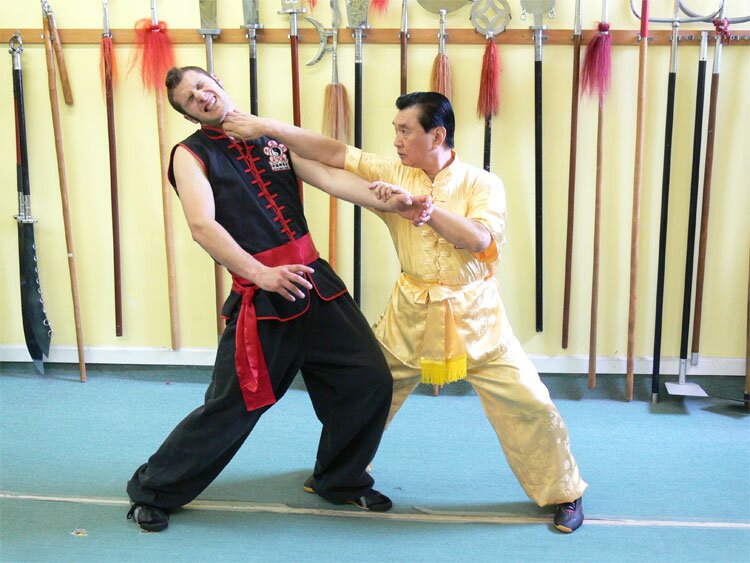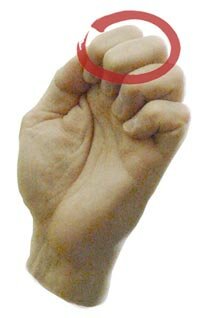The little-known half fist is one of choy li fut’s most-powerful strikes.
Often called the leopard fist, the half fist is one of the most-potent tools in choy li fut’s arsenal. It is a sharp, cutting fist that can strike a variety of vital areas, including tight ones such as the throat, eyes and solar plexus.
Unfortunately, its effectiveness is often underestimated or overlooked altogether. Modern combat sports teach strikes using the full fist, because they can deliver more power without risking a collapse of the fist’s structure. Because it is seen so rarely, the half fist has been labeled “archaic” and “obsolete.”

However, contrary to popular belief, the half fist is indeed useful in martial application. As with any arsenal, there is a time and place when each weapon can be used to its full potential. The half fist’s potency is directly proportional to the conditioning of the stylist. Following a proper conditioning program can help you reach your half fist potential in a matter of months.
Advanced Kung-Fu
The half fist is taught as an advanced fist in the choy li fut system; the general practitioner can use a full fist or palm strike without risking injury. While considered an advanced fist, the half fist is introduced early in the curriculum so the student can begin developing and conditioning needed for making the fist combat ready. Years of training will not only condition the fist, wrist and forearm for the impact of the strike, but also refine accuracy and coordination.
Conditioning the fist should never be rushed or compromised. Results are cumulative; you get what you give and much like the term kung-fu, attaining the half fist is “hard work.” The accompanying training regimen can be applied by any student of any martial arts style.
Stage 1
Forming the Fist
The first stage of developing the half fist is learning how to form the fist. The common misconception is that the fist should appear flat. Though it looks more attractive, it lacks structure and that will cause the fist to collapse upon impact. The result is injury to the wrist and forearm. The half fist should be formed by pressing the fingertips to the upper pad of the palm. Make sure to leave no gaps. The thumb presses the distal phalange of the index finger, while the pinky finger must press inward. This causes the hand to curve slightly and extend the knuckles. This compression engages the muscles and tendons in the forearm. The striking point of the half fist is the ridge of the secondary knuckles.
Proper structure is conducive to proper conditioning. Once the fist can be held tightly, it must be conditioned for impact by holding a static push-up position, with the flat of the index and middle fingers in contact with the ground, palms facing outward so wrist flexion can be monitored. The practitioner should assume this push-up position on his knees to keep from forcing too much weight over the knuckles and wrists. Hold the fist tightly without letting gaps between the fingers; the fingertips press the upper pad of the palm. The wrist must also be straight and the thumbs must maintain pressure to the index fingers.
Hold the static push-up position for one minute, making sure the hand position remains steady and the wrist is aligned with the forearm. Then relax and massage the knuckles toward the fingertips. Dit da jow may also be applied to expedite recovery. As this becomes easier, shift your weight forward and bend the elbows to concentrate more weight over the half fists. Do two-to-four sets measuring one-to-two minutes. You should soon be able perform 20 push-ups on the half fist.
 Stage 2 Stage 2
Stabilizing the Fist
The next stage is building the instantaneous impact stability of the fist. Sandbag training is used, because the practitioner can practice the punch and condition the fist without risk of injury. Much like iron palm training, the practitioner must be patient and work lightly during the outset of training. Smart training lessens the chance of damaging the nerves and joints, or disrupting circulation. Even a bruise is a sign of overdoing it. Sandbag training must be done with 100-percent concentration and intention.
When punching the bag, do not let the fist bounce off the training device. Instead, hold it with the intention of pressing through the bag. Start by punching the sandbag, alternating hands every five minutes. Increasing by five minutes each week until punches can be delivered at full speed and power for 20 minutes.
Stage 3
Form Fitting
Another facet of training is forms practice involving the half fist. This helps the practitioner develop speed and connection, as well as an understanding of the various target points. Shadowboxing serves as an excellent approach, because it develops spontaneity in combinations and builds reaction speed for practical application.
The half fist must be used selectively, because it cannot sustain the substantial impact of striking hard targets like the skull or chest. Palm strikes and full fist strikes can be delivered to hard areas of the body with little risk of injury to the hand, wrist or forearm.
The practitioner must use the right tool at the right time. This is never more apparent than in the ring. You won’t find half fists in today’s combat sports, because the strike cannot be properly formed, held or delivered with gloves. Plus, the striking force of the half fist is diminished by the glove.
Reach Advantage
The half fist gives the practitioner as much as a two-inch extension, which is vital in application. As choy li fut grandmaster Doc-Fai Wong says, “Inch long, inch strong.” But imagine the difference two inches can make when delivering a devastating strike. The half fist not only increases reach, but because it is flatter than a full fist it can squeeze into tighter spaces. It also concentrates the amount of force into a smaller striking point, making it perfect for pressure point strikes and vital area attacks.
Choy li fut half fist strikes target the eyes and nose with the cheong-ngan-chui or “snatching the eyes” strike; the throat, sternum, floating ribs and solar plexus with the jin-chui or “arrow fist” strike; and the stomach, groin and kidneys with the loi-yum-chui or “groin punch.”
In self-defense, the half fist can be used in conjunction with many martial concepts. A bridging technique can be used with the cheong-ngan-chui to redirect an oncoming punch and strike the eyes at the same time. The corkscrew motion of the yum-tsop delivers a devastating strike to the groin with not only a sharp striking surface, but also a twisting tearing action that can be used to break free from a grab.
Its potential is based on the amount of conditioning and work the practitioner puts into it. If the training regimen from this article is taken on seriously and consistently practiced, the half fist will be come one of the most important tool in your martial arts arsenal.
Brian Kuttel is a full-time instructor and student manager of the Doc-Fai Wong Martial Arts Center in San Francisco. Wong is founder and president of the Plum Blossom Federation. For more information, visit www.plumblossom.net.
|